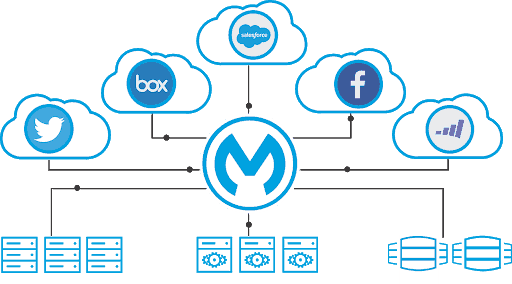Mulesoft
MuleSoft has been part of the Salesforce family for over a year. During that time, we’ve been helping companies achieve digital transformation by easily connecting all their business systems. So, what does MuleSoft do? Let’s explore the powerful world of integration.
Technology innovation created chaos
Over the last 30 years, enterprise technology has exploded. Today, the average enterprise has 900 applications and only 29% of those are connected to each other. This creates a burden on IT teams, who are tasked with implementing, maintaining, and governing an increasing number of applications and systems.
IT project demands will increase by 32% this year. But despite this growth, the majority of IT teams will see a budget increase of less than 10%, which prevents IT from focusing on innovation. A recent study of global IT leaders found that nearly 70% of IT’s time is dedicated to keeping the lights on rather than spending it on innovation.
The more digital transformation initiatives that need to be implemented, the wider the delivery gap gets. It’s a balance most organizations still struggle to find. The central pillar to solve this huge challenge is to understand how integration drives digital transformation.

So what does MuleSoft do?
Customers expect connected experiences. They don't want to see the seams where your systems and departments meet. MuleSoft brings this together by helping organizations change and innovate faster by making it easy to connect any application, data, and device with APIs — Application Programming Interfaces. APIs are messengers that take requests and tell a system what a user wants it to do, then returns the response back to that user.
MuleSoft makes it easy to unify data to deliver a single view of the customer, automate business processes, and build connected experiences. By using a modern API-led approach, each integration becomes a reusable building block. This process that optimizes a reusable process enables organizations to accelerate IT delivery, increase organizational agility, and deliver innovation at scale.
The results speak for themselves. Forrester found MuleSoft customers realize an ROI of 445% within just three years and were able to free up 90% developer time from maintaining APIs and integrations.
MuleSoft case study
Let’s use an example. One of the world’s largest consumer goods providers wanted to find more efficient solutions to deploy new products and services. Their goal was to roll out a new ecommerce initiative quickly, to engage directly with customers through both digital and in-store channels, and deliver a better customer experience.
To make this happen the company needed to connect multiple tools to its ecommerce platform, such as Salesforce Commerce Cloud, SAP, and NetSuite. Using a custom code path, they would need to:
- Spend IT time, effort, and resources to build three separate integrations while also including security considerations.
- Hire an employee who understood the thousands of fields in their ERP, the various systems required for their new ecommerce platform, and was able to build each integration.
- Create additional integrations if they ever change any of the systems they use.
How Salesforce and MuleSoft can be leveraged together
MuleSoft can connect any system, application, data, and device to unleash the power of the Customer 360. The combined power of MuleSoft, the #1 integration platform, and Salesforce, the #1 CRM, enable customers to accelerate digital transformation.
Together, MuleSoft and Salesforce give companies the ability to unlock data across systems, develop scalable integration framework, and ultimately create differentiated, connected experiences at a rapid pace. Across various integration patterns, Salesforce products, and third-party systems — the integration possibilities are endless. From developing integrated applications with Lightning Platform and Heroku, achieving a single customer view in Sales and Service Cloud by integrating siloed third-party systems, or connecting the Salesforce 360 with legacy sources to synchronize order, invoice, and product information.